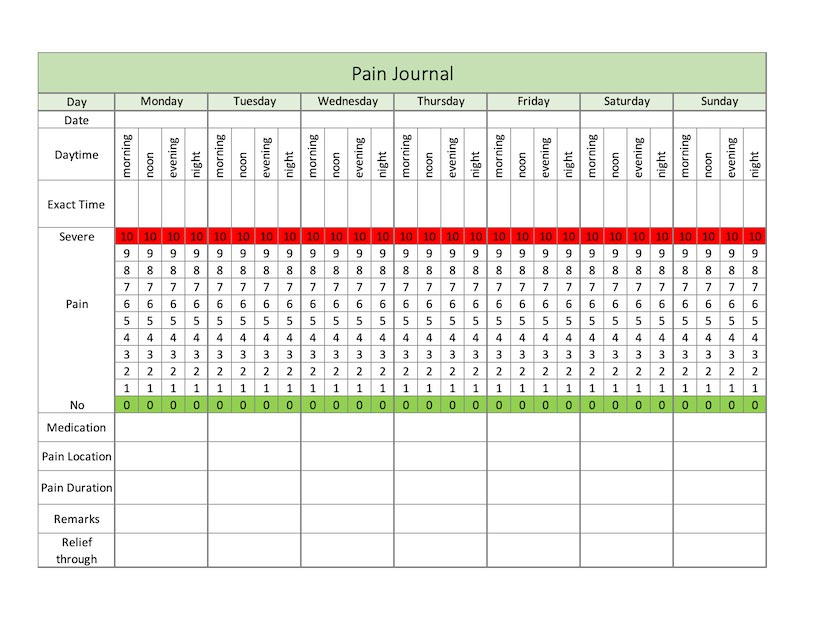
A CDC survey found that 20.4 percent of Americans live with chronic pain. Chronic pain can interfere with work and life activities. It is important to see a pain doctor and get a treatment plan, and that may include keeping a pain log. A pain log or pain diary enables you to document pain events and pain triggers, so you can take control of the pain as much as possible.
What is a Pain Diary?
A pain diary is what it sounds like. It is a way to maintain a record of pain experiences in detail. Each pain incidence is recorded, and there are good reasons why this approach might help you relieve pain to some degree. The chronic pain journal can identify the following.
- Trends in pain occurrences, like flare-ups
- Activities that trigger pain events or make the pain worse
- Details of symptoms
- Time of day or night when pain is better or worse
- Therapies and treatments that bring the most pain relief
- Pain quality
Pain quality refers to how the pain feels. Researchers identified three pain groupings for pain quality assessment.
- Paroxysmal pain – sharp, shooting, radiating and hot
- Superficial pain – numb, cold, itchy, tingling and sensitive
- Deep pain – heavy, aching, cramping, dull and throbbing
Information to Enter in the Pain Diary
The main goal of keeping a pain management diary is to improve pain management. The information in the pain diary enhances communication between you and the doctor by providing detailed information about the pain experience.
The chronic pain journal can include any information considered helpful. The American Cancer Society developed a daily pain diary that any patient can use. The pain does not have to be due to cancer. It could be back pain due to spinal disc degeneration, joint pain due to a sports injury, etc. The diary includes the following information.
- Date and time
- Pain score
- Location of the pain
- Pain quality
- What you were doing when the pain started or worsened
- Name and amount of medicine taken
- Non-medication therapies tried
- Duration of the pain
- Pain score after taking medicine and/or using non-medication therapies

The pain scale is a 10-point scale with zero meaning no pain, five indicating moderate pain and 10 indicating worst pain ever experienced.
This is only one type of pain log. You can work with your doctor to identify the information you should record in your daily pain diary for the journal to deliver the most benefits. For example, you may want to document what you ate or drank or describe your mood. You might decide to record the effect of pain on your psychological well-being. Numerous studies have demonstrated a link between chronic pain and depression.
Pain Diary Can Help Relieve Pain
A study on chronic pain due to non-cancer reasons found pain diaries can help to significantly lower pain intensity so that pain interferes less with a patient’s ability to walk, do normal work and enjoy life. Patients also experienced:
- An improved mood
- Better communication with healthcare providers
- Improved self-management of pain
- More effective treatment plans
Pain studies have found that pain journals can help people experiencing pain due to non-cancer and cancer reasons. A study on patient-reported pain experiences found that cancer patients providing their own information achieved some pain relief.
Gaining Some Control Over Pain
Often, people experiencing chronic pain feel like they have no control over their health issues or the quality of life. The pain log helps people get some control because the entries deliver critical information needed for good decision-making by the patient and help the doctor better understand what the person is experiencing. You can make several entries a day, and it will not take long to detect patterns.
Sources
- https://www.cdc.gov/nchs/products/databriefs/db390.htm
- https://pubmed.ncbi.nlm.nih.gov/18574365/
- https://www.cancer.org/content/dam/cancer-org/cancer-control/en/worksheets/pain-diary.pdf
- https://www.ncbi.nlm.nih.gov/pmc/articles/PMC5494581/
- https://www.ncbi.nlm.nih.gov/pmc/articles/PMC6361316/
- https://spcare.bmj.com/content/bmjspcare/7/4/00.1.full.pdf
